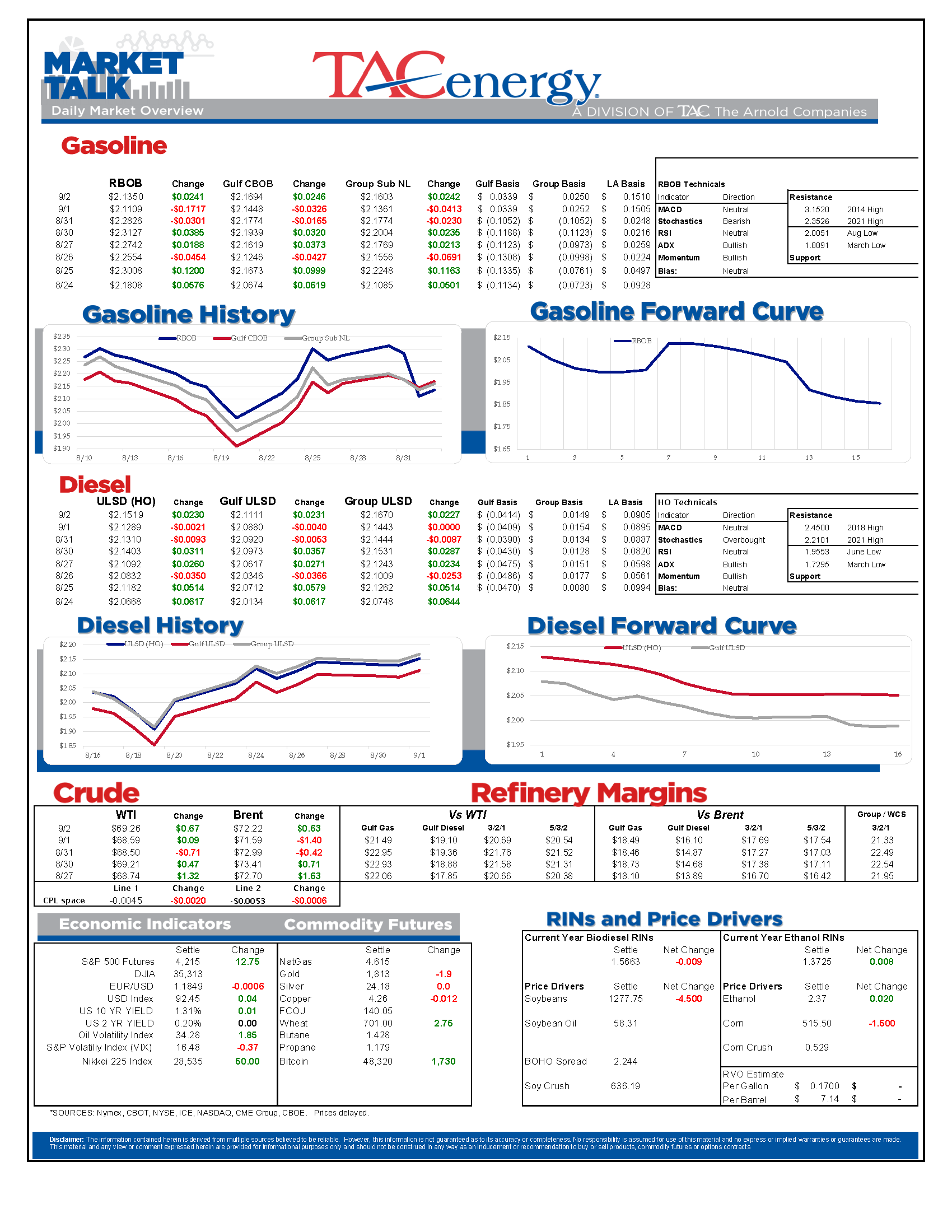Industry Continues To Grapple With Fallout From Ida

Energy futures are ticking higher this morning, recovering from modest losses to start September as the industry continues to grapple with the fallout from Ida, and uncertainty heading into the last weekend of the driving season.
Ida continues to wreak havoc, 4.5 days after first making landfall. We’re seeing dramatic images of flooding in Philadelphia and New York City and flash flood warnings continue north to Boston. No word yet if any of the few remaining refineries in PADD 1 were impacted by the storm, but given the widespread river flooding it seems at the very least we’ll see some delays in barge traffic over the next several days.
Most of the refineries in Louisiana remain offline and recovery efforts have been hampered by a combination of lack of power and flooded roads. The two largest plants, Exxon Baton Rouge and Marathon Garyville are both reportedly attempting to restart this week. The success or failure of those startups will be critical to determine how long the local fuel shortages last, and whether or not they expand to other states since the Plantation line will need their supply to continue operating.
Yesterday’s DOE report was highlighted by total US petroleum demand smashing its all-time high, nearly 500,000 barrels/day above the previous record set in the summer of 2018. Perhaps even more impressive is that record was set despite gasoline and jet fuel demand remaining below pre-pandemic levels, which is a testament to the strong growth in propane/propylene and the “other oils” category which now regularly surpass distillates as the 2nd largest demand category behind gasoline.
US Crude oil production ticked up to a post-pandemic high of 11.5 million barrels/day, but will drop more than 1 million barrels next week due to the Gulf of Mexico shutdowns.
News & Views
View All
Energy Futures Are Caught Up In Headline Tug-O-War This Morning
Energy futures are caught up in headline tug-o-war this morning with Canadian oil production concerns and a positive US GDP report trying to push prices higher while sinking Chinese demand worries and Gaza ceasefire hopes are applying downward pressure. The latter two seem to be favored more so far this morning with WTI and Brent crude oil futures down ~45 cents per barrel, while gasoline and diesel prices are down about half a cent and two cents, respectively.
No news is good news? Chicago gasoline prices dropped nearly 30 cents yesterday, despite there not being any update on Exxon’s Joliet refinery after further damage was discovered Wednesday. Its tough to say if traders have realized the supply situation isn’t as bad as originally thought or if this historically volatile market is just being itself (aka ‘Chicago being Chicago’).
The rain isn’t letting up along the Texas Gulf Coast today and is forecasted to carry on through the weekend. While much of the greater Houston area is under flood watch, only two refineries are within the (more serious) flood warning area: Marathon’s Galveston Bay and Valero’s Texas City refineries. However, notification that more work is needed at Phillip’s 66 Borger refinery (up in the panhandle) is the only filing we’ve seen come through the TECQ, so far.
Premiums over the tariff on Colonial’s Line 1 (aka linespace value) returned to zero yesterday, and actually traded in the negatives, after its extended run of positive values atypical of this time of year. Line 1’s counterpart, Line 2, which carries distillates from Houston to Greensboro NC, has traded at a discount so far this year, due to the healthy, if not over-, supply of diesel along the eastern seaboard.
Click here to download a PDF of today's TACenergy Market Talk.

WTI And Brent Crude Oil Futures Are Trading ~$1.50 Per Barrel Lower In Pre-Market Trading
The across-the-board drawdown in national energy stockpiles, as reported by the Department of Energy yesterday, stoked bullish sentiment Wednesday and prompt month gasoline, diesel, and crude oil futures published gains on the day. Those gains are being given back this morning.
The surprise rate cut by the People’s Bank of China is being blamed for the selling we are seeing in energy markets this morning. While the interest rate drop in both short- and medium-term loans won’t likely affect energy prices outright, the concern lies in the overall economic health of the world’s second largest economy and crude oil consumer. Prompt month WTI and Brent crude oil futures are trading ~$1.50 per barrel lower in pre-market trading, gasoline and diesel are following suit, shaving off .0400-.0450 per gallon.
Chicagoland RBOB has maintained its 60-cent premium over New York prices through this morning and shows no sign of coming down any time soon. Quite the opposite in fact: the storm damage, which knocked Exxon Mobil’s Joliet refinery offline on 7/15, seems to be more extensive than initially thought, potentially extending the repair time and pushing back the expected return date.
There are three main refineries that feed the Chicago market, the impact from one of them shutting down abruptly can be seen in the charts derived from aforementioned data published by the DOE. Refinery throughput in PADD 2 dropped 183,000 barrels per day, driving gasoline stockpiles in the area down to a new 5-year seasonal low.
While it seems all is quiet on the Atlantic front (for now), America’s Refineryland is forecasted to receive non-stop rain and thunderstorms for the next four days. While it may not be as dramatic as a hurricane, flooding and power outages can shut down refineries, and cities for that matter, all the same, as we learned from Beryl.

